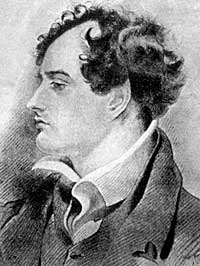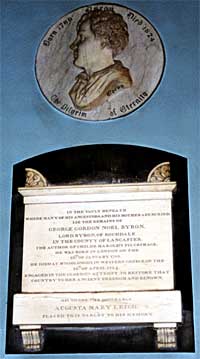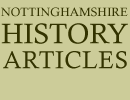
George Gordon, 6th Lord Byron (1788-1824).
Five children of the Hon. William Byron, of Bulwell Wood Hall (the eldest son of Richard, second Lord Byron) were also interred here. His eldest son, William, an infant, who is quaintly described in the registers as "Esquire William Byron the sonne of William Byron, Esq.," was buried April the 13th, 1664; Richard, another of his sons, was buried March the 8th, 1665-6; Henrietta Maria, one of his daughters, was buried August the 10th, 1671; Ernest, another son, was buried March the 9th, 1672-3; and Anne, another daughter, was buried April the 5th, 1675. On the death of his father in 1679, the Hon. William Byron succeeded to the peerage as third Lord Byron. He was twice married, and Elizabeth, his first wife, who was the daughter of John, Viscount Chaworth, was buried at Hucknall Torkard, June the 20th, 1683. It was this lady who, in 1664, gave the handsome silver-gilt chalice and paten now belonging to Hucknall Church. The third Lord Byron was himself buried at Hucknall, November the 16th, 1695, but no monument was erected to his memory. His eldest surviving son, William, fourth Lord Byron (for he had two sons named William) was three times married. His first wife, Mary, daughter of John, Earl of Bridgwater, died of small-pox, April the 10th, 1703, only eleven weeks after her marriage, and it is stated that when the vault was opened in 1824, a coffin was seen with this inscription:
"The body of the Right Hon. the Lady Mary Egerton, eldest Daughter of John, Earl of Bridgwatcr, and wife of the Right Hon. William, Lord Byron, who died the 10th April, 1703, in the 27th Year of her Age." It would thus appear that this lady was interred at Hucknall, though the burial does not appear in the registers. This may perhaps be accounted for by the supposition that Lady Byron's remains were first deposited in some church near to the place where she died, and were subsequently removed to the Byron Vault at Hucknall. It should be added that the peerages give the 11th of April, instead of the 10th, as the date of her decease. Her husband was married secondly to Frances Williaminc, daughter of William, Duke of Portland, by whom he had four children, all of whom died in their childhood. According to the registers only two of them were buried at Hucknall, namely, George, who was buried there July the 19th, 1719, and Frances, buried there September the 24th, 1724. Lady Byron died at Kensington, March the 31st, 1712, and her remains being brought to Hucknall Torkard, were interred in the family vault on the 7th of the following month. In 1720, Lord Byron was married thirdly to Frances, daughter of William, Lord Barkley of Stratton, by whom he had five sons and a daughter, and dying himself August the 8th, 1736, was buried at Hucknall Torkard. His eldest son by his third wife succeeded as fifth Lord Byron, and gained, perhaps undeservedly, the soubriquet of "the wicked Lord." It was this nobleman who killed his neighbour, Mr. Chaworth, of Annesley, in a duel. He married in 1747, Elizabeth, daughter and coheiress of Charles Shaw, Esq., of Besthorpe Hall, in Norfolk, by whom he had several children. One of his daughters, the Hon. Frances Elizabeth Byron, was buried at Hucknall, June the 24th, 1768, and he himself was buried there June the 16th, 1798. The Hon. William Byron, M.P. for Morpeth, his only son, who lived to manhood, died in 1776, leaving an only son, William Frederick Byron, sometime an officer in the Nottinghamshire Militia. He was killed in Corsica in 1794, so that upon the decease of his grandfather in 1798, the title devolved upon George Gordon Byron, the poet, whose grandfather, Admiral John Byron, better known in his day as "foul-weather Jack," was a younger brother of the fifth Lord. The poet's mother, was buried here in August, 1811, and on the 16th of July, 1824, the remains of the poet was brought here from Missoloughi and deposited in the vault amidst his ancestors. He was last peer of his family whose remains have been interred at Hucknall Torkard, but the vault has been since opened to receive the body of his only daughter, Augusta Ada, Countess of Lovelace, who died November the 27th, 1852. The mural monuments to the poet and his daughter are upon the south wall of the chancel, and upon the opposite wall hangs a hatchment having the arms of Byron upon a lozenge, with an niescutcheon of pretence bearing the arms of Gordon quarterly with another coat, apparently incorrectly represented. The hatchment is that of the poet's mother, who was buried here, as already mentioned, in 1811. Beneath the poet's mural tablet hangs a small funeral achievement, painted upon silk, having these arms upon a shield, ensigned with a baron's coronet: Quarterly; first and fourth. Argent, three bendlets enhanced gules. Byron; second and third, quarterly, first and fourth, Azure, a mullet of six points argent between three boars' heads couped or, Gordon; second and third, Azure, a fesse engrailed between three pheons or—evidently intended for Davidson, but incorrectly represented.

Monument to Lord Byron at Hucknall Church (A Nicholson, 2002).
The vault itself is constructed at the foot of a small flight of stone steps beneath the pavement, in the centre of the chancel towards the eastern end. It is described as being remarkably small and incommodious. Contemporary accounts state that the Coffin of the Poet was placed beside that of his mother, upon an ancient leaden coffin without inscription. The vault has now been permanently closed.
(Major) A. E. LAWSON LOWE, F.S.A.
Shirenewton Hall,
Near Chepstow.
